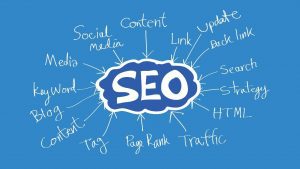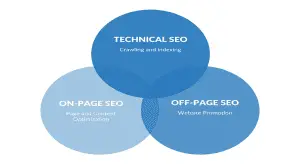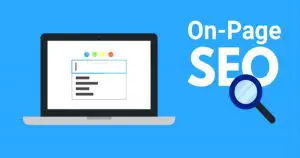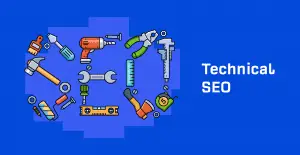SEO Marketing: What It Is And How It Works
When it comes to SEO Marketing, there are many opinions, so many answers to one question, which shows how complicated and amass it is.
Every website owner should have basic knowledge of how SEO works, as it will improve website ranking which leads to more brand visibility. In this article we would cover topics like:
- What is SEO ?
- Types of SEO ?
- Meaning of on-page SEO ?
- What is off-page SEO ?
- Meaning of technical SEO ?
What is Search Engine Optimization ?


SEO stands for search engine optimization. SEO is a set of procedures for optimizing a website to increase website visibility for better productivity, such as Increased website traffic leading to various job opportunities and income
In simple terms, SEO is the process concerned with creating and improving your website to be visible to search engines like Google, when people search for your website or business online. Your pages can have a lot of potential visitors if it is visible to users on the search results.
In simpler terms, it means a practice of enhancing organic traffic on the search engine results page to make it rank higher for more brand visibility.
But what are those practice that makes a good SEO optimization:
- Create materials/content under the control of your keyword analysis.
- Make use of catchy titles and headlines.
- Create compelling meta descriptions
- Make sure of image optimization
- Insert varieties of internal hyperlinks.
- Make available user-friendly design (on mobile and desktop)
What Are The Types Of SEO ?


Do you want to induce the maximum amount of traffic to your website? You’re going to be wanting more than one optimization…
There are square measure three all-around organic search strategies which are:
- On-page SEO
- Off-page SEO
- Technical SEO
These SEO techniques will facilitate web site you want to target. By breaking down your strategy, It’ll be a lot easier to arrange and execute your optimization goals.
We’ll go over each sort of SEO and how they fit into your entire marketing plan in this piece.
What Is On-page SEO ?


On-page SEO focuses on the optimization of a website’s content and structure to improve its ranking in search engines. There are several ways to achieve on-page SEO, which include optimizing titles, meta descriptions, and the anchor text; adding relevant keywords to titles and tags; using online search engine optimization (SEO) techniques such as keyword density and keyword placements;
Overall, on-page SEO is an important part of any website’s marketing strategy, because it can help to increase traffic and conversion rates.
The Element Of On-page SEO optimization
For on-page SEO, there are no globally accepted procedures. Howbeit, the analysis, and implementation strategies should be as extensive as doable, to guarantee that every potential for enhancing search engine rankings is taken advantage of.
Even if there isn’t a straightforward step-by-step approach to improving on-page aspects of websites, the subsequent list tries to hide the bulk of the foremost common parts, which are divided into four categories:
1) Enhancement of technical capabilities
A website’s three primary technological components that can be optimized includes:
Server Response Time
Because search engines use website load times as part of their ranking algorithm, improving server response times is an important aspect of on-page SEO
The Source Code
Improved website performance can be added by efficient source code. To make it easy for the Google bots to index the site, unnecessary functionalities or code portions can be often be deleted or other aspects combined
Internet Protocol (IP) Addresses
These are accustomed to deciding if, for example, you’ve got a foul neighborhood problem, for example, you ought to continuously have a singular IP address for every internet project. This sends a message to Google and other search engines.
2) Content
In this context, content refers to more than just visible on-screen items like text and photos. It also includes features that aren’t apparent at first, such as alt-tags and metadata.
Text
Text optimization has been long done on the basis of keyword density. This method has been replaced, first by using WDF*IDF tools to weight terms, and then, at a higher level, by concluding topic cluster analyses to prove terms and relevant terms.
The goal of text optimization should always be to develop a text that not only revolves around a single keyword but also includes term combinations and complete keyword clouds to the best of one’s ability. This is how to guarantee that the content accurately describes a topic.
This is how you can make sure your information is as precise and comprehensive as possible when it comes to describing a topic. It is no longer sufficient to optimize texts only for the purpose of search engines.
Text Structural Elements:
These include using paragraphs or bulleted lists, h-heading tags, and bolding or italicizing specific text components or words
Graphics Section
Every image is a valuable content element that can be improved. They can help improve the content’s relevance, and well-optimized photos can rank in Google’s image search on their own.
At the same time, they can make a website more appealing to visitors. Users will spend more time on your site if you have appealing image galleries, and the names of the files one aspect of picture optimization is the use of graphics.
Videos
A lot of what pertains to photographs conjointly applies to videos as well, SEO’s and webmasters ought to pay special attention to whether or not the audiovisual content on their pages can be watched by users.
Meta-tags:
On-page SEO includes meta titles, which are crucial page elements for rankings, and meta descriptions, which are an indirect factor that affects the CTR (click-through rate) in search engine pages.
Eleven though consumers cannot see them right away, they are still regarded as part of the content because they should be optimized alongside the texts and images. This makes it easier to guarantee that the keywords and topics addressed in the text are closely related.
3) Internal Linking And Structure
Internal linking is often accustomed to guide a bot’s visit to your domain and additionally to optimize navigation for human people.
Logical Structure And Crawl Depth:
the goal here is to properly structure menus and limit the number of level hierarchies to four. The fewer layers there are, the faster a bot can reach and crawl all of the sub-pages.
Internal Linking
Internal linking influences how link juice is maintained and disseminated throughout a site and can aid in increasing the relevance of sub-pages for a specific keyword. A strong sitemap is one among the foremost vital on-page SEO basics there’s, and extremely relevant, each for users making an attempt to navigate around the domain and for program crawlers.
Canonization
Using existing canonical tags and/or designing pages with a no-index attribute are two ways to avoid duplicate materials
URL (Uniform Resources Locator Structure) Structure
This entails determining whether or not search engine-friendly URLs are being utilized, as well as whether or not the current URLs are logically related to one another. Uniform resources locator length (URL) may be checked out as part of on-page improvement.
Focus
Pages that don’t contain any notably helpful content and maybe thought-about unmeaning for the Google index, ought to be robots meta tag “noindex”, which can forestall them from being enclosed within the search results
4) Design
Usability is a crucial consideration in today’s web designs. To improve the page’s operation, complex graphics (such as those created using flash) are frequently replaced with simpler alternatives. Other aspects, such as JavaScript apps, can be similarly affected.
Mobile Optimization
This is the process of altering a website’s desktop content to make it accessible and viewable on mobile devices such as smartphones and tablets
File Sizes
Pictures or graphics that are large will drastically increase the load time of a page. SEOs and graphic designers should maintain file sizes as little as feasible as part of their on-page optimization.
Call-To-Action
Specific page components ought to be accustomed to simulate user action by encouraging interaction with the website. Our Search metrics Ranking Factors studies have more information on on-page (and off-page) optimization.
What Is Off-page SEO ?


Off-page SEO, also known as “off-site SEO” is a type of search engine optimization that takes place outside the website, it is an indirect activity that occurs outside your site which includes link-building, social networking, and digital marketing.
By doing so, you boost your website reputation and boost your DA (domain authority) and PA (page authority).
Off-page SEO optimization tactics for higher ranking:
- Link building
- Use of social media
- Bookmarking on social media
- Blogging as a guest
- Developing a brand
- Marketing with content
- PR
- Local search engine optimization
- Forums
- Marketing with influencers
- Events
- Podcasts
- Reviews
- Syndication of content
What Is Technical SEO ?


The term “technical SEO” refers to the process of correcting the technical faults of a website. It refers to website and server enhancement that aids search engine spiders in more efficiently crawling and indexing your site to help improve organic ranking.
Whatever is connected to a page and a website, which is in control by web developers and webmasters is referred to as technical SEO.
It can also be termed as the act of optimizing specific aspects of your website on the server so that people can quickly navigate your search engine bots and can successfully crawl and index them. These changes are made to your website’s “behind-the-scenes” code.
The following elements make up technical SEO techniques
- Website structure
- Indexability
- Site loading time
- Indexing
- Web design that is responsive
- Structural data
- Schema
- Mobile-friendliness
- Security
SEO might be hard to implement all at once, but practicing these tactics would help boost your website ranking tremendously.


